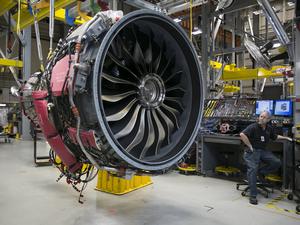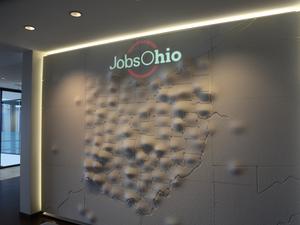Drive Capital's $1 billion in new VC funds launches it into a small but growing club of firms raising megafunds – but on a U.S. map, it looks lonely.
Sixteen of the 21 firms with $1 billion-plus commitments from limited partners through July this year are based in Silicon Valley, New York City, Boston and Seattle.
Firms in those four metro areas accounted for 89% of overall new funds raised in the first half of the year, according to PitchBook and the National Venture Capital Association. Zero new VC funds were raised in 25 states and territories.
While Drive’s leaders would welcome company in Columbus, Ohio where it's based, they also are seizing on the competitive advantage of access to entrepreneurs and talent in the overlooked middle.
“This investment model that we built here in Columbus, it works,” said Drive co-founder and partner Chris Olsen. “As much work as we’ve done here, wait until you see what comes next.”
The now $2.2 billion firm has broadened its decade-long focus on the Midwest to back startups in Atlanta, Austin and Denver – anywhere that’s not the coastal biggies – which in turn raises the prominence of Columbus.
Last year, Drive distributed $300 million worth of returns while also investing $300 million into more startups, Olsen said. Its $250 million first fund raised in 2012 has returned more than what LPs put into it, with more upside to come.
“We were right: That the economy of tomorrow is really going to be built in places like Columbus and that there’s nobody investing here,” he said. “And while we’ve got this window in time to take advantage of it, we’re going to do so.”
From September through the first week of July, Drive raised $400 million for its fourth seed and early-stage fund and $600 million for its Overdrive fund for later growth-stage tech companies. About 95% of limited partners from previous funds returned, and many increased their commitments.
Olsen said that was faster than Drive expected.
‘We want more Drive Capitals’
This is only the second year ever that venture capital firms have raised more than $100 billion combined, according to PitchBook, even as their investing in tech startups has slowed amid inflation and economic uncertainty. The $137.5 billion in funds to date already are close to breaking last year’s record $142 billion.
Individual funds greater than $1 billion are a recent phenomenon, led by huge firms such as Tiger Global and Andreessen Horowitz, NVCA CEO Bobby Franklin said. Almost all are in the coastal epicenters – the concentration has only increased in the past decade.
“We want to see more Drive Capitals spread out across the country,” Franklin said. “Our basic thesis is entrepreneurs are everywhere, but they’re likely not going to be able to take their shot at building a high-growth company if there’s not an ecosystem.”
Rather than diminishing Columbus’ importance, Drive’s wider territory can strengthen the region, said Lori Kendall, senior lecturer at Ohio State University’s Fisher College of Business. She spent decades building and advising tech companies in Silicon Valley.
“Columbus will stop being provincial in the eyes of the rest of the country as it is part of an interconnection of cities that create a larger footprint than any one of those cities can create by themselves,” she said.
“As an entrepreneur I benefit from ... those connections; I benefit from that exposure,” she said. “I say this passionately as somebody who spent most of my life outside Columbus: Why the hell shouldn’t Columbus be part of a larger community?”
Drive creates a halo effect that’s helping smaller neighbors even when there’s hardly any overlap in investors or portfolio, said Wolf Starr, CEO of Atlas Venture Partners, a consulting firm that with Loud Capital is building several early-stage funds for inclusive social impact investing in Columbus.
“Most of our investors are from outside the region,” Starr said. “This just brings a great spotlight to Columbus.”
Drive’s ability to raise funds in the current environment gives Janine Sickmeyer optimism for emerging managers like herself, she said via email.
The Upper Arlington entrepreneur is general partner in Overlooked Ventures, which is in the early stages of raising its first $50 million fund to invest in diverse founders.
Portfolio companies backed by Drive’s first $1.2 billion have created 8,000 jobs. The tech slump has hit some, however: In Columbus this year, Drive-backed Root Inc. and Olive AI Inc. have cut hundreds of employees.
Now Drive can write larger checks for more mature tech companies, which Olsen said will create thousands more jobs and likely reshape the Fortune 500.
“Imagine how much impact that will have on these kinds of cities like Columbus and the other places in the ‘Driveway,’” he said, referring to the firm’s territory.
The economic benefit spreads beyond the portfolio to the industries they transform.
“It’s really the application of technology to traditional industry that enables entrepreneurs to build products and services that are just better, faster, cheaper than the way we used to do it in the past,” Olsen said.
“I look at companies like (Columbus-based) Path Robotics and I think there’s a fear of what a robot can do for manufacturing,” he said. “But actually ... every one of their customers who buys a robot actually hires more people.”
‘Secret’s out on Columbus’
When Mark Kvamme and Olsen left Silicon Valley’s Sequoia Capital to start Drive in 2012, their colleagues said they were crazy – including Andy Jenks, who at the time worked in San Francisco.
Three years later, Jenks moved to Columbus and joined Drive Capital as partner.
“The original Drive thesis, for which I was not a believer a long time ago ... it’s not only held up, it’s gotten stronger,” Jenks said.
There’s a belief in Silicon Valley that tech companies build in middle America only to cut costs, Jenks said, but it’s a myth. The Googles of the world are head-hunting in the Drive portfolio.
“The truth is, there are great, great world-class engineers ... in our backyard,” he said. “They don’t want to move to the Bay Area.
“We get A players, and they are kind of (paid) A rates because they can get a job anywhere.”
Ohio State’s Kendall spent most of her career in Silicon Valley, founding and advising several startups before earning her doctorate at Case Western Reserve University. She moved to Columbus in 2015.
“I was in despair,” she said. “I wasn’t sure I would get a tech job here.”
The vibe has changed, she said, because of efforts of a determined entrepreneurial community including Drive and Rev1 Ventures, and successes including CoverMyMeds and the Drive portfolio.
Kendall started at Ohio State three years ago. These days, there’s a wait list for her 250-student entrepreneurship course.
“I’m meeting people who are athletes, theater majors, music majors, agriculture majors, engineering majors – they’re all talking about starting companies,” she said.
“And they talk about wanting to stay in Columbus and being afraid of having to go to the coasts.”
Last year, big coastal firms including Sequoia Capital invested in Central Ohio companies and didn’t force employees to move, like they might have in the past.
“They’re buying into the thesis that you can build a great tech company anywhere,” Jenks said. “I don’t think Drive is the reason for it, but I think we’ve been able to prove it.”
Drive moved several early startups to Columbus – Olive from Baltimore, Beam Benefits from Louisville, Battleface from the UK.
Matt Carroll, CEO of Boston-based Immuta, moved to Central Ohio while working closely with the partners. Now that the data security company is a unicorn, valued at $1 billion in a recent $100 million VC round, he’s ready to return east while Immuta’s Short North office keeps growing.
Today, companies are choosing to move without Drive asking them, Olsen said.
“The secret’s out on Columbus,” he said. “There’s more technology companies getting built here than probably any other Midwestern city. ... But it’s not just Columbus.”
Drive’s broader territory adds to its several other strengths, Kendall said, including a network of co-investors, advisers, customers and talent – and willingness to stick with its entrepreneurs for the long haul, seeing them through tough times.
“Drive does represent an ethos for me of what I think has made venture capital very successful along the coasts,” Kendall said.
“With Drive hitting that $2 billion, I think it very well could be a significant tipping point for Columbus,” she said. “This is enough money to get attention.”








